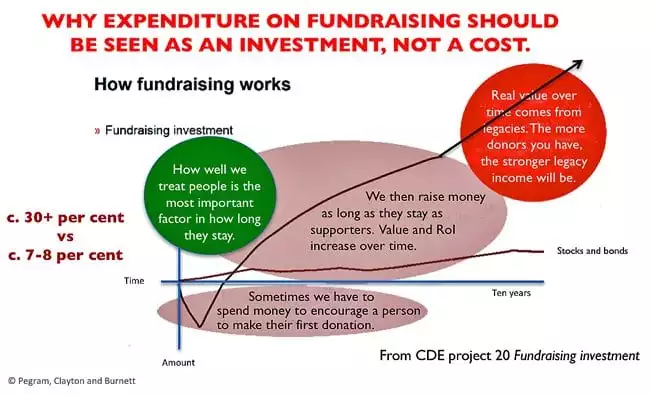2018: will fundraisers persist in missing what matters most?
Yes. Unless charity boards and managements wake up to the need to invest in the donor experience.
“Charities are also suffering from poor investment income… There was a time when investment income made a big difference to the charitable sector. For most, those times have long gone. There is, however, another problem which too many charities refuse to acknowledge but which is fundamental — they are also suffering from a collapse of trust.”
Anthony Hilton, London’s Evening Standard, 13 December 2017
At first glance Mr Hilton’s two statements above seem only loosely connected. They are anything but. If correct (the first is unarguable and the second is heard from bedrock charity supporters far too often these days) then the reality behind them is not just shameful, it’s simply idiotic and unjustifiable. If in recent years, instead of inflicting unwelcome, intrusive fundraising upon their donors, charities had invested in delivering a consistently good experience for them, then the solution to the first problem would have rapidly led to the solving of the second. Rather than sitting glumly on low-yield stocks and bonds, fundraising charities might have more usefully invested a chunk of their reserves in delivering a consistently great donor experience – effective storytelling, honest communication and heart-warming donor service – so as to build a welcoming culture that would ensure happier donors motivated to stay longer and give more. Sure, they might have been obliged to forgo some short-term, unsustainable income for a while and might have dented their reserves briefly, while laying foundations for a secure long-term future. Better by far than what happened though, don’t you think?
But no. Instead, by opting for policies of ‘short-term money now and hang the consequences’, Britain’s charities have sown the seeds of public estrangement, leading to at best their own discomfort, perhaps even their own destruction.
The furore that surrounded the untimely death of Mrs Olive Cooke was a wake-up call unparalleled in our sector’s history. Yet despite all that’s been said and written these past two years about what’s gone wrong in charity fundraising and how to put it right, charity leaders still haven’t learned, still are yet to show that they have the humility, foresight, commitment and courage to invest adequately and change their culture sufficiently to deliver a consistently attractive experience that will encourage donors to give gladly and stay giving longer.
And we shake our heads in disbelief at the short-sightedness of politicians…
Advertisement
What hope is there, in 2018, that change will come?
Some, perhaps. See here. But most probably, not enough. Summarising our sector and why we should stick at it my old buddy and business partner George Smith once said to me,
‘It’s a lousy world. Someone should change it. It might as well be us.’
All these years I’ve believed it really could be us. Here are four reasons why, followed by a premonition of impending failure.
- The market for something to believe in is infinite. It’s inflation-proof and recession-resistant. It’s the only market that matters, for fundraisers.
- We charity fundraisers have the best stories in the world to tell and the best of reasons for telling them well, with emotional power and passion that will move people to action. It’s what we should excel at and work to get better at.
- Our supporters are seeking meaningful ways to make a difference. They want to be the change that George and all the rest of us have so longed to see. And we can offer these wonderful, generous people fulfilment, comfort, satisfaction and feedback that illustrates real achievement – a truly rewarding experience when they decide to become a donor. Real value for money too.
- There are lots of them and their numbers are growing. If we can only get the donor experience right, the potential for substantial change will come.
But unless and until we get better leadership in our flagship organisations, that change won’t happen in anything other than isolated instances. I greatly fear that the UK’s fundraising sector is not sufficiently focused or united to lead that change.
I hope to be proved wrong. The UK’s Institute of Fundraising’s Project on the Donor Experience, led by CDE co-founder Giles Pegram CBE and project chair Chris Washington-Sare, is a bright light focused on the way forward. It needs to be prominently front and centre of everything to do with fundraising in the UK in 2018. It must not be sidelined, or consigned to a backwater. Charities must start making real and concrete the promise to donors that the Commission on the Donor Experience (CDE) called for, and the blueprint for change that they defined.
I’m well aware I’ve become like a broken record on this subject (see links below – they’re just the tip of it). The coming year, 2018, will see me enter my 42nd year as a professional fundraiser. As 2017 comes to its close, it seems to me to be time to go. I’ll leave you with this illustration, below, in the hope that you might pause to ponder what it shows, alongside the four change-the-world reasons listed above and my fear-laden conclusion below them.
Because it doesn’t have to be. Change can come. But only if enough of us unite, so we can make it so.
A simplified illustration of how investment in fundraising works
Good fundraising won’t happen without prudent investment. This diagram shows why, for any fundraising charity, it makes so much sense to invest appropriately in the donor experience and donor relationship development. Read it from bottom left to top right.
“…far more was involved than a stormy media climate. That was merely the canary in the coalmine signalling the need for dramatic and fundamental change in the way our sector does business.”
Roger Craver and Tom Belford, US-based website The Agitator, 19 June 2017
Related articles
• The positives of working together.
• Spend less on programmes.
• Don’t invest in stocks and shares.
• Changing fundraising for good.
• Doing the right thing by donors.
• The future of fundraising: a five-part series.
© Ken Burnett 2017
This article was first published on kenburnett.com and is republished with permission.





